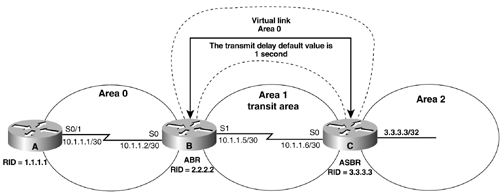2-22 area transit-area-id virtual-link router-id transmit-delay seconds
| < Free Open Study > |
2-22 area transit-area-id virtual-link router-id transmit-delay secondsSyntax Description:
Purpose: When an LSA is created, the router will set the LS age field to 0. The transmit delay value is added to the age field of the LSA. This initial value represents the time delay of propagating the LSA over the virtual link. Initial Cisco IOS Software Release: 10.0 Configuration Example: Modifying the Transmit Delay Value for a Virtual LinkConfigure the network in Figure 2-22 and set the transmit delay value to 2 seconds. Figure 2-22. Transmit Delay Represents the LSA Propagation Delay Over a Virtual Link Router A interface Loopback0 ip address 1.1.1.1 255.255.255.255 ! interface Serial0/1 ip address 10.1.1.1 255.255.255.252 clockrate 64000 ! router ospf 1 network 10.1.1.0 0.0.0.3 area 0 network 1.1.1.1 0.0.0.0 area 0 _______________________________________________________________________ Router B interface Loopback0 ip address 2.2.2.2 255.255.255.255 ! interface Serial0 ip address 10.1.1.2 255.255.255.252 ! interface Serial1 ip address 10.1.1.5 255.255.255.252 clockrate 64000 ! router ospf 1 area 1 virtual-link 3.3.3.3 transmit-delay 2 network 10.1.1.0 0.0.0.3 area 0 network 2.2.2.2 0.0.0.0 area 0 network 10.1.1.4 0.0.0.3 area 1 _______________________________________________________________________ Router C interface Loopback0 ip address 3.3.3.3 255.255.255.255 ! interface Serial0 ip address 10.1.1.6 255.255.255.252 ! router ospf 1 area 1 virtual-link 2.2.2.2 transmit-delay 2 network 3.3.3.3 0.0.0.0 area 2 network 10.1.1.4 0.0.0.3 area 1 VerificationVerify that the transmit delay value has been modified, that the virtual link is active, and that all OSPF routes are being exchanged. rtrB# show ip ospf virtual-links Virtual Link OSPF_VL0 to router 3.3.3.3 is up Run as demand circuit DoNotAge LSA allowed. Transit area 1, via interface Serial1, Cost of using 64 Transmit Delay is 2 sec , State POINT_TO_POINT, Timer intervals configured, Hello 10, Dead 40, Wait 40, Retransmit 6 Hello due in 00:00:01 Adjacency State FULL (Hello suppressed) _______________________________________________________________________ rtrC# show ip ospf virtual-links Virtual Link OSPF_VL7 to router 2.2.2.2 is up Run as demand circuit DoNotAge LSA allowed. Transit area 1, via interface Serial0, Cost of using 64 Transmit Delay is 2 sec , State POINT_TO_POINT, Timer intervals configured, Hello 10, Dead 40, Wait 40, Retransmit 5 Hello due in 00:00:03 Adjacency State FULL (Hello suppressed) rtrC# show ip route Codes: C - connected, S - static, I - IGRP, R - RIP, M - mobile, B - BGP D - EIGRP, EX - EIGRP external, O - OSPF, IA - OSPF inter area N1 - OSPF NSSA external type 1, N2 - OSPF NSSA external type 2 E1 - OSPF external type 1, E2 - OSPF external type 2, E - EGP i - IS-IS, L1 - IS-IS level-1, L2 - IS-IS level-2, * - candidate default U - per-user static route, o - ODR Gateway of last resort is not set 1.0.0.0/32 is subnetted, 1 subnets O 1.1.1.1 [110/129] via 10.1.1.5, 00:02:25, Serial0 2.0.0.0/32 is subnetted, 1 subnets O 2.2.2.2 [110/65] via 10.1.1.5, 00:02:26, Serial0 3.0.0.0/24 is subnetted, 1 subnets C 3.3.3.0 is directly connected, Loopback0 10.0.0.0/30 is subnetted, 2 subnets O 10.1.1.0 [110/128] via 10.1.1.5, 00:02:26, Serial0 C 10.1.1.4 is directly connected, Serial0 Troubleshooting
|
| < Free Open Study > |
EAN: 2147483647
Pages: 236
